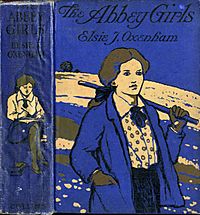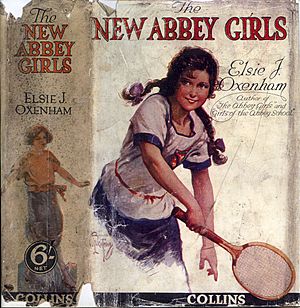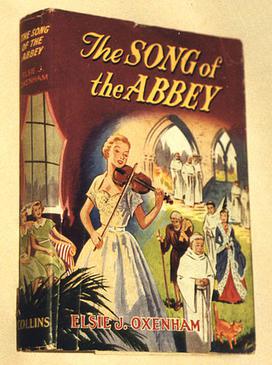Abbey Series facts for kids

Pictorial boards from the first edition, (1920), of the book which gave its name to the whole series
|
|
| Author | Elsie J. Oxenham |
|---|---|
| Illustrator | Arthur A. Dixon |
| Cover artist | presumably also Arthur A. Dixon |
| Country | United Kingdom |
| Language | English |
| Series | The Abbey Series |
| Genre | Girls' Novels |
| Publisher | Collins |
|
Publication date
|
1st edition 1920 |
| Media type | Print (hardback) |
| Pages | 320 |
| Preceded by | The Girls of the Hamlet Club |
| Followed by | The Girls of the Abbey School |
The Abbey Series is a collection of 38 British novels written by Elsie J. Oxenham. These books were published between 1914 and 1959. The first book, Girls of the Hamlet Club, introduces the school setting. However, it's the second book, The Abbey Girls, that brings in the special place called The Abbey. This Abbey is a beautiful old ruin that feels like a character itself. It makes people love it as a calm, peaceful spot and inspires them to be helpful and public-spirited, just like the old Cistercian monks who once lived there. These special qualities are a big reason why the series became so popular.
Contents
Elsie Oxenham's Abbey Books
Girls of the Hamlet Club (1914) is set at Miss Macey's school in Wycombe and the nearby villages. The story is about Cicely Hobart, who moves to Whiteleaf to be close to her grandparents. She used to live in London but now stays with an old family helper and goes to school in Wycombe.
Cicely finds that the school is divided. There's the 'real school' group and the 'hamlets' group. The 'hamlets' are mostly girls who got scholarships and live in the countryside. They can't afford extra things like school clubs, which have high fees to keep them out. Cicely decides to organize the 'hamlets' into The Hamlet Club. Their motto is 'To be or not to be' from Shakespeare's Hamlet, and their badge is the Whiteleaf Cross, a local landmark.
As the club grows, its members learn Morris and Country Dancing. They also prepare a May Queen ceremony for Cicely's grandparents. The Hamlet Club ends up saving the day for the school when the main actors in the school play get sick. They bravely share their secret club activities to help the school, and Miriam Honor becomes the first May Queen.
The Abbey Girls (1920) is the second book in the series. It tells the story of two red-headed cousins, Joan and Joy Shirley. It shows how they both manage to get into Miss Macey's School in different ways. These two cousins are the first 'Abbey Girls'. The series then follows their adventures and the friends they make, not just during their school days but also as they grow up.
An early friend, Jen Robins, quickly becomes a very important character. Other friends like Jandy Mac, Rosamund, and Maidlin also become known as 'Abbey Girls'. By the end of the series, these six main characters are all married with children. The stories then start to focus on the adventures of the daughters of Joan, Joy, Jandy, and Jen, who attend the same school.
There wasn't a real 'Abbey School'. However, the book The Girls of the Abbey School (1921) describes how the school spent a term at Abinger Hall. This was Joy Shirley's home, and it had the ruined Gracedieu Abbey on its grounds. The Abbey in the books was based on Cleeve Abbey in Somerset, England. This real abbey is an English Heritage property that people can visit in the summer. Oxenham "moved" this ruin to Oxfordshire, near the Buckinghamshire border, for the story of The Abbey Girls. This helped connect the cousins with the characters from the first book, Girls of the Hamlet Club.
| code | Title | Date | Publisher | Illustrator |
|---|---|---|---|---|
| First Generation Titles | ||||
| A01 | The Girls of the Hamlet Club | 1914 | Chambers | Harold Earnshaw |
| A02 | The Abbey Girls | 1920 | Collins | Arthur Dixon |
| A03 | The Girls of the Abbey School | 1921 | Collins | Elsie Anna Wood |
| A11 | The Abbey Girls Go Back to School | 1922 | Collins | Elsie Anna Wood |
| A13 | The New Abbey Girls | 1923 | Collins | Elsie Anna Wood |
| A14 | The Abbey Girls Again | 1924 | Collins | Elsie Anna Wood |
| A15 | The Abbey Girls in Town | 1925 | Collins | Rosa C Petherick |
| A16 | The Queen of the Abbey Girls | 1926 | Collins | E. J. Kealey |
| A12 | Jen of the Abbey School | 1927 | Collins | frontis. E. A. Wood, others F. Meyerheim |
| A17 | The Abbey Girls Win Through | 1928 | Collins | not credited |
| A18 | The Abbey Girls at Home | 1929 | Collins | Inder Burns |
| A19 | The Abbey Girls Play Up | 1930 | Collins | not credited |
| A20 | The Abbey Girls on Trial | 1931 | Collins | 'C.P.S.' |
| A21 | Biddy's Secret | 1932 | Chambers | Nina K. Brisley |
| A22 | Rosamund's Victory | 1933 | Harrap | Victor Cooley |
| A23 | Maidlin to the Rescue | 1934 | Chambers | Rene Cloke |
| A24 | Joy's New Adventure | 1935 | Chambers | Rene Cloke |
| A25 | Rosamund's Tuckshop | 1937 | R.T.S./G.O.P. | not credited |
| A26 | Maidlin Bears the Torch | 1937 | R.T.S./G.O.P. | not credited |
| A27 | Rosamund's Castle | 1938 | R.T.S./G.O.P. | not credited |
Abbey Connections
Elsie Oxenham wrote other book series that connect to the main Abbey Series. These are called Abbey Connectors. Sometimes, characters from other books or series are brought into the Abbey Series. This can sometimes make the timeline a little tricky.
Oxenham also wrote about 20 books that have no connection at all to the Abbey Series. These are known as Non-Connectors.
About the Author
Elsie J. Oxenham sometimes wrote herself into her books as 'The Writing Person'. You can see this in books like The New Abbey Girls and The Abbey Girls Again. To learn more about the author, you can read the article about Elsie J. Oxenham.
Main Ideas in the Series
Several important ideas and interests of Elsie Oxenham appear often throughout the Abbey Series.
Folk Dancing
Oxenham loved folk dancing and often included it in her stories. Folk dancing is mentioned in almost all 38 Abbey books. The English Folk Dance Society and its important members are even shown in some of the books, sometimes with their real names and sometimes with nicknames.
May Queens
Another big idea in the series is May Queens. The Hamlet Club, which started in the first book, chose one of their members as a May Queen. By the time of Abbey Girls, this had become a school tradition for three years. By the end of the series, in Two Queens at the Abbey, the club is 27 years old. Joy's twin daughters are crowned as the 28th joint Queens. It's thought that Oxenham might have been inspired by the May Queen tradition at Whitelands College.
Christian Faith
Oxenham grew up in the Congregational Church. Her beliefs and way of looking at life are clear throughout the series. She doesn't preach, but her characters talk about why good and bad things happen. As they do, their own beliefs grow. This helps to show how deep and complex the characters are, beyond just their actions.
Elsie Jeanette Oxenham Fan Society
One fun thing for fans and members of the EJO Society is finding and visiting the real places that Oxenham used in her books. Besides the Bucks/Oxon area and the village of Washford, Somerset (where Cleeve Abbey is), several books are set in parts of Sussex, Wales, Lancashire, the English Lake District, and Scotland. Of course, these places aren't always exactly like their real-life versions. Oxenham was writing fiction, so she could move an abbey nearly 200 miles if it helped her story. Changing a few names or making distances shorter or longer was also perfectly fine for her books.



